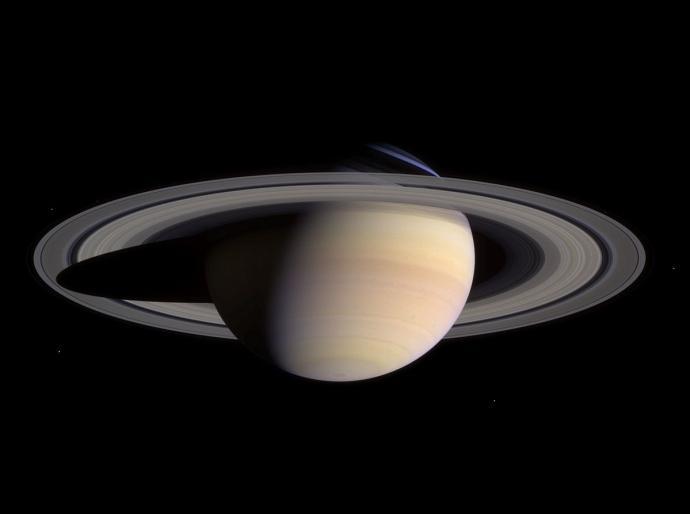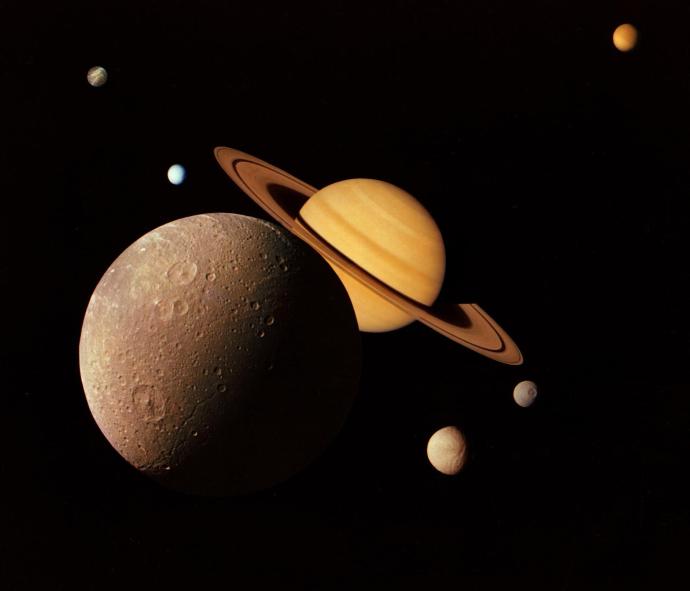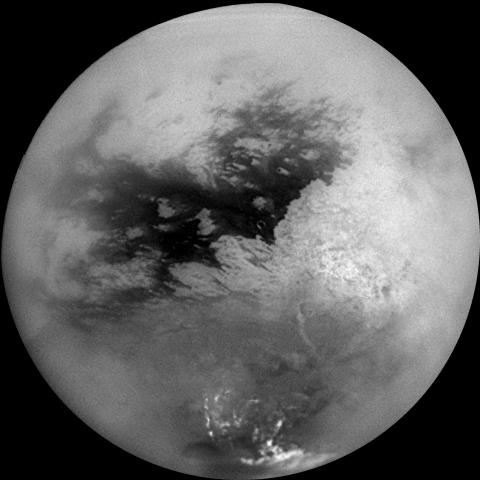Saturn is the sixth planet from the Sun and the second largest planet in the Solar System.
Saturn is a gas giant planet like Jupiter and does not have a solid surface. It is made mainly of the gases hydrogen and helium.
Saturn is the only planet in our Solar System with an average density which is lower than water. This means that if you could find a bathtub big enough, Saturn would float!
You probably know Saturn for its dramatic and beautiful rings. Saturn is not the only planet to have rings, but they are the biggest and brightest. It might surprise you to know the rings are not solid. They are made up of many millions of pieces of ice and rock! The pieces orbit Saturn to make a system of 7 rings. Each ring orbits Saturn at a different speed. The lumps of ice and rock in the rings range in size from a few centimetres to several metres across. Although the rings look impressive, they are only about 1 km thick. But they are very wide - 250,000 km in diameter!
Saturn is covered in layers of clouds that give it its yellow, brown and white stripes. Winds in the clouds can be as fast as 500 metres per second. This is faster than winds in the strongest hurricanes on Earth. Cold winds at Saturn's north pole create a remarkable hexagon shape in the clouds.
Saturn spins on its axis like the Earth, so it has day and night. It has the second shortest day of the 8 planets. One day on Saturn is about 10 and a half hours! Much shorter than Earth's 24 hours. Saturn's axis is tilted by about 27 degrees. This is similar to Earth's tilt of about 23 degree which means Saturn also has seasons! But the seasons pass by much more slowly because it takes Saturn over 29 Earth years to orbit the Sun.
As well as rings, Saturn has dozens of moons. Saturn's largest moon, Titan, is bigger than Mercury and the dwarf planet Pluto! Titan is large enough to have its own atmosphere. Scientists think Titan and another of Saturn's moons (Enceladus) have oceans beneath their surfaces. This means they could contain the right conditions for life.
The first space-probe to visit Saturn was Pioneer 11 in 1979. There have been several others since then. The Cassini-Huygens probe spent 13 years studying Saturn and orbited it 294 times!

- Moons
Saturn has more than 140 moons moons. Some are tiny rocks nearly 1 km across. Others are massive. Saturn's moon Titan is bigger than the planet Mercury.
One of the most famous moons of Saturn is called Enceladus. Space probes have seen jets of water vapour and ice being thrown out of the surface and into space. Scientists think this is because it has an ocean which covers the planet and is hidden below a thick crust of ice. Another moon, Mimas, might also have water on its surface.
In addition to the moons, Saturn also has a series of rings which are made of small rocks, dust and ice. Most of these objects are microscopic, but there are some rocks in the rings which have diameters of hundreds of metres. It is thought that the orbit of Saturn's moons give the rings their shape. Especially the gaps in between them.
Image CreditThis work by NASA/JPL is licensed under Creative Commons Zero v1.0 Universal
CreditThis work by NASA/JPL is licensed under Creative Commons Zero v1.0 UniversalA montage of Saturn's Moons - Titan
Titan is Saturn’s largest moon. It is bigger than the planet Mercury and only slightly smaller than Ganymede. Not only is Titan huge, it more like a planet than a moon in lots of ways.
Titan is the only moon with a thick atmosphere. It is mainly made of nitrogen, like on Earth. It also contains methane gas. This is broken down by the Sun to make a thick smog which covers the planet’s surface. Astronomers use infrared images to cut through the smog and see the surface.
Winds blow across the moon's surface moving clouds of methane. It doesn't rain water on Titan, but liquid methane. This means the surface is covered with huge lakes of liquid methane and ethane. These can evaporate off into the clouds and fall as rain again, just like the water cycle on Earth.
The temperatures on Titan are freezing, averaging -179 °C. This means methane can be either solid, liquid or gas, just like water on Earth. The moon is the only place, other than Earth, to have liquid flow on the surface. There are rivers, gorges and coastlines. The Cassini probe landed on Titan in 2005. It came down on a bed of water ice pebbles which were frozen harder than rock and worn smooth by the flow of liquid methane.
There are more likenesses to Earth too. Large dunes are formed near the equator by high winds. Instead of being made of sand, they are made of hydrocarbons which look like coffee grounds. There are volcanoes that erupt liquid water, which then sets like rock (ice) in the cold. The water comes from an ocean buried under Titan’s surface. Some astronomers think this ocean may be able to support life.
Image CreditThis work by NASA/JPL/Space Science Institute is licensed under Creative Commons Zero v1.0 Universal
CreditThis work by NASA/JPL/Space Science Institute is licensed under Creative Commons Zero v1.0 UniversalTitan
